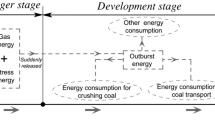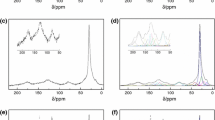Abstract
Eight types of samples: crude oil, chloroform bitumen A, oil fractions (saturated hydrocarbon, aromatic hydrocarbon, resin and asphaltene), source rock and kerogen, have been pyrolyzed in laboratory. The products have also been systematically analyzed. The results indicate that gaseous hydrocarbons yields for different types of samples at various temperatures are different, especially for different fractions of crude oil. There is difference for molecular compositions. The C2/C3 ratios of cracking gases in different types of samples have positive relationships with C2/iC4 as well as pyrolysis temperatures. Moreover, the ratios of C2/C3 and C2/iC4 are about 2 and 10, respectively, at the temperature of 500°C–550°C. However, when the temperature is higher than 500°C, the ratios of C1/C2, C1/C3 and dryness index for gases cracking from source rock and kerogen are higher than those from oil and bitumen, indicating an important different feature between oil-cracked gases and kerogen-cracked gases at the high or over-mature stage. The ratios of C1/C2, C1/C3 vary more than 10% at 500°C–800°C. In this paper, experimental results can provide important academic foundation and useful geochemical parameters for distinguishing of oil-cracked gases and kerogen-cracked gases.
Similar content being viewed by others
References
Wang H Y, Yang T Y. An analogue experiment of gas generating by crude oil cracking (in Chinese). Natural Gas Industry, 1982, 2(3): 28–33
Bjoroy M, Williams J A, Dolcater D L, et al. Variation in hydrocarbon distribution in artificially matured oils. Organic Geochem, 1988, 13(4–6): 901–913
Hao F, Guo T L, Zhu Y M, et al. Evidence for multiple stages of oil cracking and thermochemical sulfate reduction in the Puguang gas field, Sichuan Basin, China. AAPG Bull, 2008, 92(5): 611–637
Zhao M J, Lu S F. Natural gas from secondary cracking of crude oil—An important pattern of gas generation (in Chinese). Geoll Rev, 2000, 46(6): 645–650
Behar F, Kressmann S, Rudkiewicz J L. Experimental simulation in a confined system and kinetic modelling of kerogen and oil cracking, Simulation and modelling of kerogen and oil cracking. In: Maxwell C B, Larter J R, Manning S R, et al., eds. Adv Org Geochem, 1992, 19(1–3): 173–189
Horsfield B, Schenk H J, Mills N, et al. An investigation of the in-reservoir conversion of oil to gas: compositional and kinetic findings from closed-system programmed-temperature pyrolysis. In: Maxwell C B, Larter J R, Manning S R, et al., eds. Adv Org Geochem, 1992, 19(1–3): 191–204
Behar F, Vandenbroucke M, Teermann S C, et al. Experimental simulation of gas generation from coals and marine kerogen. Chem Geol, 1995, 126: 247–260
Behar F, Vandenbroucke M, Tang Y, et al. Thermal cracking of kerogen in open and closed systems: determination of kinetic parameters and stoichiometric coefficients for oil and gas generation. Org Geochem, 1997, 26(5/6): 321–339
Behar F, Lorant F, Budzinski H, et al. Thermal stability of alkylaromatics in natural systems: kinetics of thermal decomposition of dodecylbenzene. Energy Fuels, 2002, 16: 831–841
Hill R J, Yongchun Tang, Kaplan I R. Insights into oil cracking based on laboratory experiments. Org Geochem, 2003, 34(12): 1651–1672
Prinzhofer A, Huc A Y. Genetic and post-genetic molecular and isotopic fractionations in natural gases. Chem Geol, 1995, 126: 281–290
Prinzhofer A, Mello M R, Silva Freitas L C, et al. New geochemical characterization of natural gas and its use in oil and gas evaluation. In: Mello M R, Katz B J, eds. Petroleum Systems of South Atlantic Margins: AAPG Memoir, 2000. 73: 107–119
Wang Z P, Fu X T, Lu S F, et al. An analogue experiment of gas generating by crude oil cracking, characters of products and its significance (in Chinese). Nat Gas Indust, 2001, 21(3): 12–15
Feng Z H, Chi Y L, Du H W, et al. Carbon isotopic composition and yield of gaseous hydrocarbon by oil hydrous pyrolysis in reservoir rock medium (in Chinese). Acta Sedimentol Sin, 2002, 20(3): 505–509
Zhao M J, Zeng F G, Qin S F, et al. Two pyrolytic gases found and proved in Tarim Basin (in Chinese). Nat Gas Indust, 2001, 21(1): 35–38
Chen S J, Fu X W, Ma L N, et al. Genetic identification method of kerogen-cracked gases and oil-cracked gases (in Chinese). Petrol Geol Exp, 2002, 24(4): 364–371
Zhao M J, Zhang S C, Liao Z Q, et al. The cracking gas from crude oil and its significance in gas exploration (in Chinese). Petrol Explor Devel, 2001, 28(44): 47–56
Yi C H, Wang T D, Wang S Y, et al. Differences between kerogen and oil cracked gases in Sinian reservoirs of Weiyuan and Ziyang area (in Chinese). Acta Sedimentol Sin, 2001, 19(1): 156–160
Qin S F, Li M, Dai J X, et al. Types of cracking gas in Hetianhe gas field in Tarim Basin (in Chinese). Oil Gas Geol, 2005, 26(4): 455–460
Author information
Authors and Affiliations
Corresponding author
Additional information
Supported by the National Key Science and Technology Program of China during the 10th Five-Year Plan Period (Grant No. 2004BA616A02-01-01-03)
Rights and permissions
About this article
Cite this article
Zhang, M., Huang, G., Hu, G. et al. Geochemical study on oil-cracked gases and kerogen-cracked gases (I)—Experimental simulation and products analysis. Sci. China Ser. D-Earth Sci. 52 (Suppl 1), 1–9 (2009). https://doi.org/10.1007/s11430-009-5009-5
Received:
Accepted:
Published:
Issue Date:
DOI: https://doi.org/10.1007/s11430-009-5009-5




